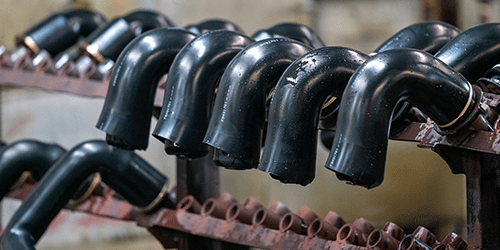Your project needs a gasket, but what type of material should you choose? There’s a lot that goes into answering that question, such as: the type of environment in which it will be used, the kinds of materials it will be exposed to, and the temperatures it will encounter. Once those specifications have been determined, a choice of gasket material can be made.
It’s a thin sheet of material that creates a seal where two surfaces meet. It’s a small component – but extremely important – because it prevents fluids or gases from escaping and contaminants from entering. This ensures valuable materials don’t leak or hazardous ones don’t cause damage to the system, environment, or nearby humans.
It’s a small component with a big job.
Given the critical function gaskets perform, it’s important to choose the correct gasket for your intended application and environment. A key part is the gasket’s material, which plays an enormous role in how it performs, and one of the best gasketing materials is sponge rubber.
When compressed, solid rubber tends to spread outward, which is an issue in sealing applications because the material deforms and eventually loses its ability to seal. Because sponge rubber is softer, returns to its original shape after being compressed, and doesn’t spread out much, it has a distinct sealing advantage for both interior and exterior applications. It also is very resistant to extreme temperatures, UV radiation, and ozone, and specific sponge rubber formulations resist oils, acids, and alkalis, to name just a few.
There are two types of sponge: open cell, and closed cell. Both are manufactured to create an air-filled matrix structure that makes it lighter and softer than solid rubber, but whereas open cell sponge allows air and fluids to pass between cells, closed cell does not. For this reason, closed cell sponge is typically firmer than open cell.
An example of an open cell structure is the sponge you use to wash your car. When put in a bucket of soapy water, the open cells absorb the water, and when you squeeze the sponge, the water is released. Open cell is great for washing your car but not for sealing. Gasketing applications typically used closed cell sponge rubber to prevent fluid from escaping the system and to keep contaminants out.
Sponge rubber is available in several formulations, each with unique performance characteristics that make it suitable for specific applications, so let’s look at several types of sponge rubber gasket materials in more detail.
EPDM sponge is one of the most popular choices for sponge rubber gaskets because of its versatility and lower cost than other polymers. It offers great compressibility and can handle exposure to acids and alkalis, heat and steam, oxidation and UV rays, and water. It resists damage from aging and is color stable, which makes it perfect for use in the outdoors. It can handle temperatures from -40° F to 250° F.
Neoprene is a very versatile synthetic rubber that can be used in harsh environments because of its resistance to oils, grease, acids, alkalis, oxidation and UV exposure, and general weathering. It also has excellent temperature resistance and stays flexible in temps from -40° F to 150° F. Closed cell neoprene is available in soft, medium, and firm durometers.
Nitrile sponge is one of the most common materials for gaskets and seals and has excellent resistance to acids, gasoline and other petroleum-based liquids, oils, alkalis, and hydraulic fluid. It can handle temperatures from -40° F to +250° F. and is an ideal solution when gas and liquid permeability and abrasions are an issue. Closed cell nitrile sponge is available in soft, medium, and firm.
Sponge rubber gaskets can also be made of FDA-approved materials for use in the food and beverage industry. Food quality sponge gaskets are safe for use with consumable products because they are resistant to bacterial growth and buildup, can handle a wide temperature range, offer chemical resistance, and are odorless and tasteless.
These sponge rubber gaskets are commonly used in food and beverage facilities:
The exact choice of sponge rubber is best left to rubber engineers that are intimately familiar with the properties of each type of gasketing material, their strengths, weaknesses, and use cases.
Sperry & Rice formulates and mixes our own sponge rubber formulations. Our in-house mixing and testing labs can ensure that your sponge rubber component performs for its intended use and environment just as specified. We can create your custom sponge rubber gaskets from all the above-mentioned materials, as well as food grade, FDA-approved gaskets. We also do everything it takes to ensure your project gets from concept to completion – on time and on budget.
Have a project that requires sponge rubber gaskets? Contact us!
